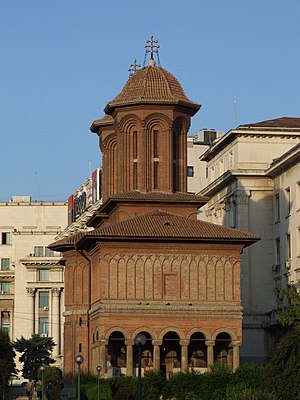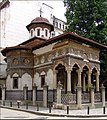Brâncoveanu style

Kretzulescu Church , Bucharest
The Brâncoveanu style is an architectural style named after the Wallachian prince Constantin Brâncoveanu (1688–1714) , which can be found mainly in the south of today's Romania . It combines Italian-Venetian and oriental style elements. Characteristic features are loggias supported by twisted columns, combined round and lancet windows, overhanging wooden roofs and lush facade ornaments with plant motifs. At the beginning of the 20th century, this architectural style experienced a kind of renaissance as the Neo-Brâncoveanu style. The most famous buildings in the Brâncoveanu style include Mogoșoaia Castle , the Horezu Monastery , the Stavropoleos Monastery and the Brâncovenesc Hospital .
gallery
literature
- Violeta Barbu: Miniatura Brâncovenească. Manuscrise ilustrate și ornamentate . Ed. Meridians, Bucharest 2000.
- Historic Houses of Romania blog: "Brancovenesc Style". Valentin Mandache's weblog, accessed on August 10, 2013.
- Vasile Drăguț: Dicționar enciclopedic de artă medievală românească , Bucharest 2000.


